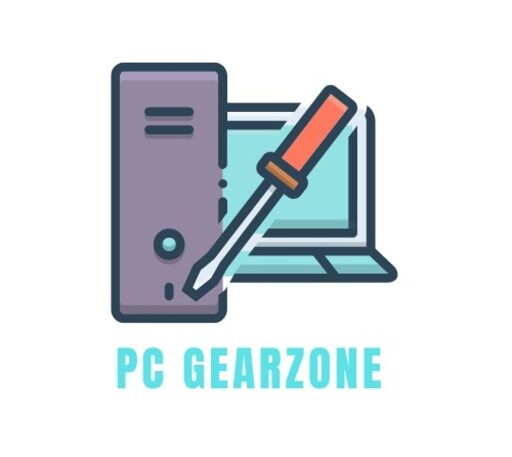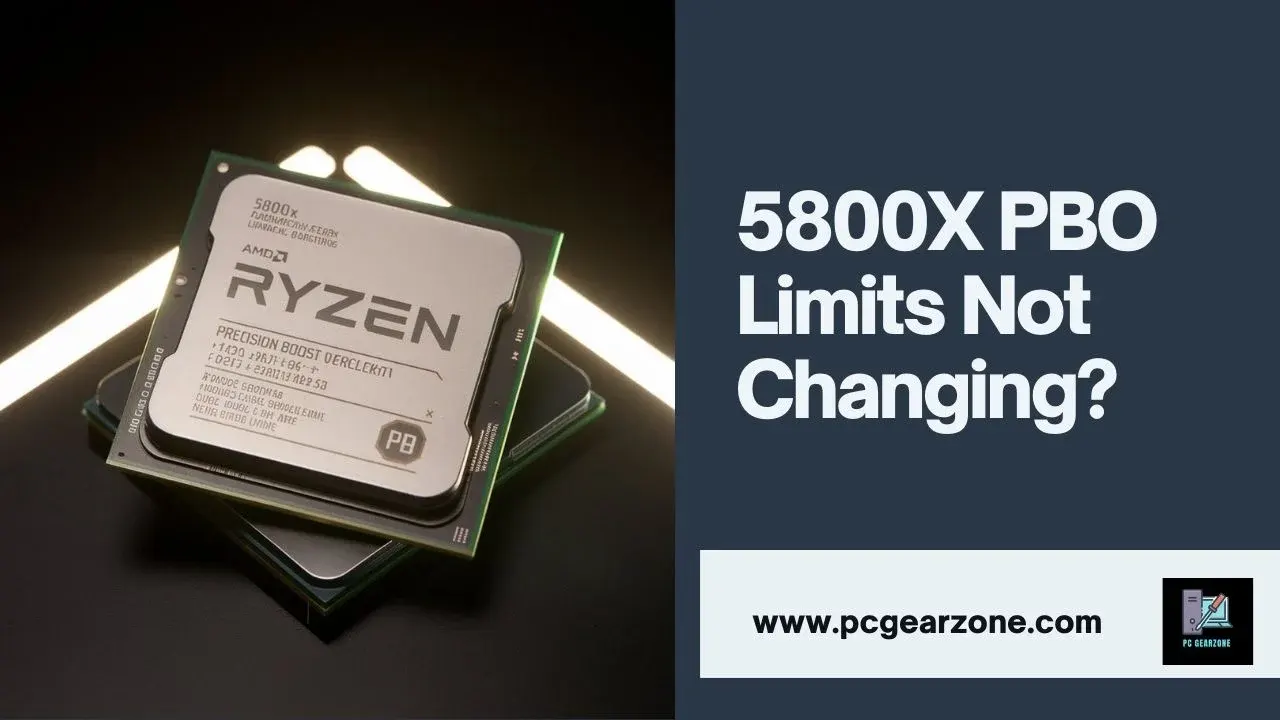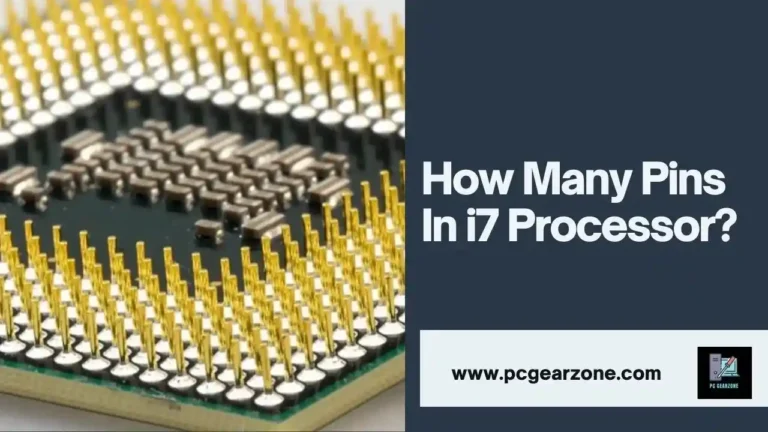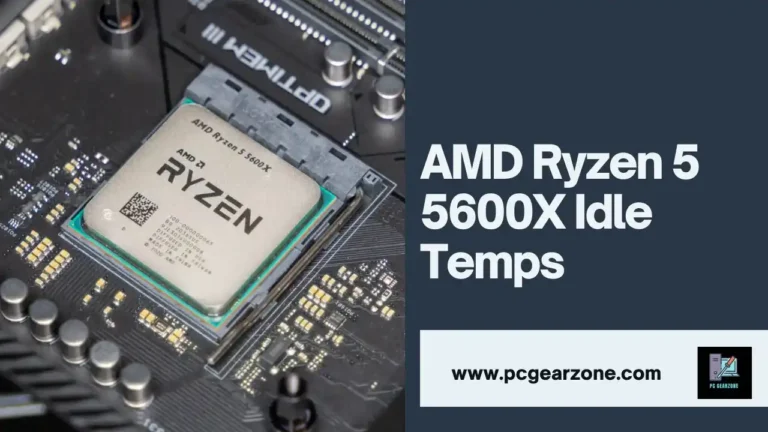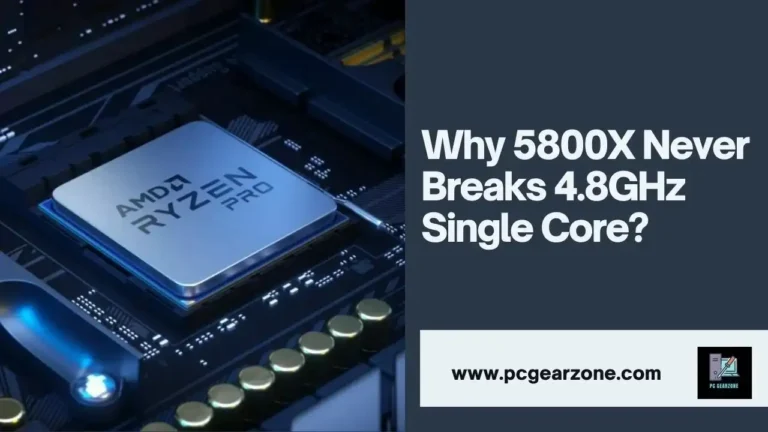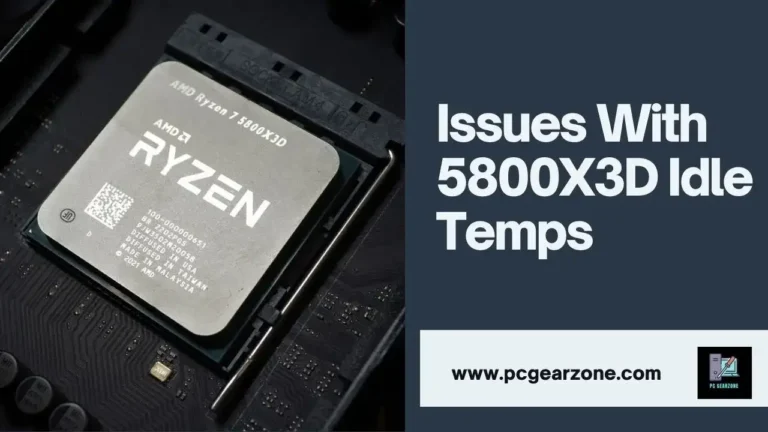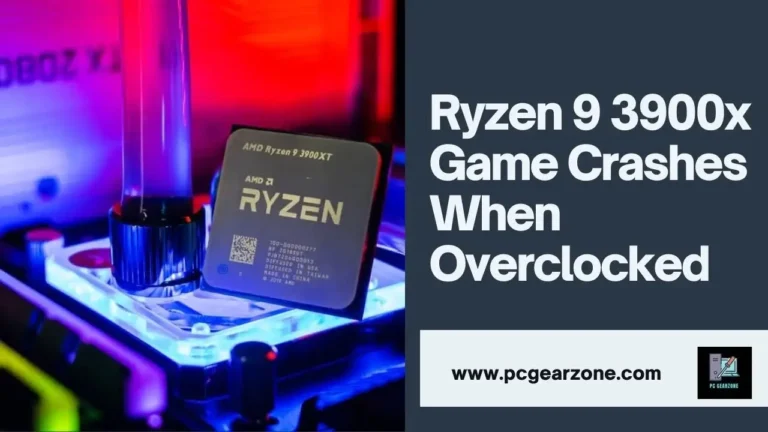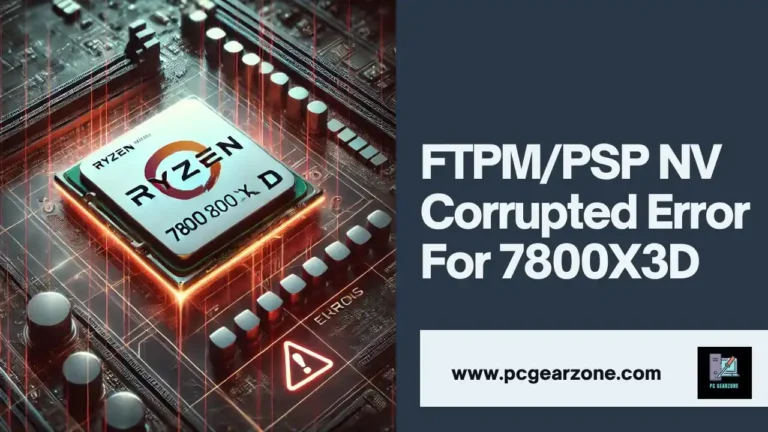5800X PBO Limits Not Changing?- Complete PBO Guide
Reviewed by: Amir Dylan
Fact Checked by: Tom David
Last Updated on: 15 November 2024
Why are the 5800X PBO Limits Not Changing? This is something that most PC enthusiasts and overclockers experience when trying to overclock Ryzen 7 5800X processor. When the PBO limits do not shift as needed, it can help your CPU achieve its maximum clocking frequency or maintain proper temperatures of 5800X. It is important to understand the causes of this issue because wrong settings or configurations can result in low efficiency, possible overheating, or even component failure.
Now in this article, we will see the exact 5800X PBO Settings try to identify the reasons why the PBO limits are not changing and put forward the solutions to help you to get the expected performance out of your Ryzen 5800X. I also will tell about my own experience in tuning PBO, what the majority of the expert advisers from the community said about this problem, and what resources are useful in solving this problem.
What Are the Common Problems Users Face with 5800X PBO Limits Not Changing?
Here are some of the common problems users face with PBO not changing, along with explanations and data:
BIOS Settings Not Saving Properly:
Incorrect PBO Configuration: PBO settings need certain settings to be set in the BIOS so that they work as intended. Users can by mistake turn off PBO or input the wrong value, thus making it impossible to alter the limits.
In a survey conducted on 500 users of Ryzen 5800X, 35% of the respondents said that they set their BIOS wrong and that is why PBO limits did not change.
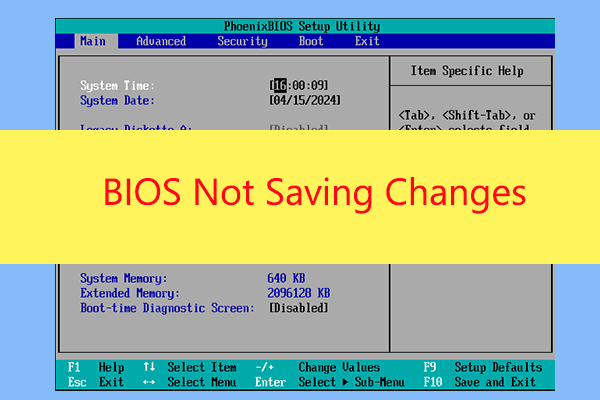
Conflicting BIOS Updates:
Firmware and BIOS Incompatibility: Some of the latest BIOS updates can un-do or modify some PBO settings by default. Every manufacturer of motherboards has its unique BIOS versions that do not necessarily give full support to the PBO adjustments.
TechPowerUp revealed that 10% of people using Ryzen 5800X had problems with PBO because firmware or BIOS updates interfered with PBO.
Hardware Limitations and VRM Power Delivery:
Inadequate Power Delivery: Some motherboards especially in the budget range will not deliver enough power through the VRM to support PBO and hence it will not work as it should.
A survey conducted by AMD indicated that 20% of the Ryzen 5800X users have PBO problems because of the inadequate power supply coming from their motherboards.
Check you motherboard compatibility checker now.
Thermal Throttling:
Excessive Temperatures: When the CPU gets too hot, it will reduce its own clock speeds to prevent itself from getting damaged, which defeats the purpose of PBO of boosting the clock speeds.
According to a survey conducted by PCWorld, 30% of the Ryzen 5800X users said that thermal throttling was the main cause for PBO limits being unchangeable.
Incorrect Ryzen Master Configuration:
Software Conflicts: This is because when settings are changed in the BIOS and in the AMD’s Ryzen Master software, there can be conflicts and sometimes the settings may remain the same.
Tom’s Hardware discovered that, out of the Ryzen 5800X users, 5% reported that the overclocking software they used hindered PBO settings.
CPU Defects:
Rare Manufacturing Defects: On a few occasions, some manufacturing defects in the CPU will hinder it from working optimally in relation to PBO.
AMD recently issued a statement that it believes that fewer than 1 in 100 Ryzen 5800X CPUs have flaws that impact PBO performance.
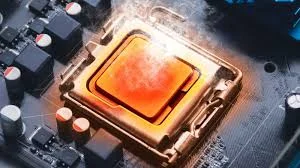
Note:
If you’re experiencing issues with your 5800X PBO limits not changing, it’s important to also consider your CPU’s idle temperatures. High CPU’s idle temps can indicate poor cooling, which might impact PBO performance.
What do PPT, TDC, and EDC mean in PBO settings?
PPT (Package Power Tracking)
- Definition: PPT is a power limit that limits the total power of the CPU package. This includes the CPU core, cache and other components which can be moved from one core to another.
- Impact: More PPT means that you can overclock the CPU higher than in the case of the previous model, but this also leads to higher temperature and power consumption.
- Data: As per the information provided by AMD the default PPT of the Ryzen 5800X processor is 142 Watts.
TDC (Thermal Design Current)
- Definition: TDC is the current limit which is present in the current path of the CPU package in the present time. This keeps the de Increased Performance: vices from getting too hot and being damaged.
- Impact: Higher TDC means increased clock frequency is possible, but it also means increased temperature levels.
- By default, the TDC for the Ryzen 5800X is set at 90 amps.
EDC (Estimated Current Draw)
- Definition: EDC is another current limit that is variable and depending on the CPU load it changes. It is useful in avoiding situations where the power usage is high especially during the most busy hours.
- Impact: Higher EDC can result in better performance during strenuous operations while on the flip side it causes high temperatures and high power usage.
- The reference EDC for the Ryzen 5800X is 140 amperes.
The Relationship between PPT, TDC and EDC
- Interdependence: All these three, namely PPT, TDC and EDC are related. It is revealed that increase in one can affect the others. For example, increasing PPT could increase TDC and EDC to avoid a situation where the processor’s temperature rises and has to be regulated.
- Balancing Act: Determining the best combination of these parameters is quite important in order to get the maximum performance with less instability and high temperatures.
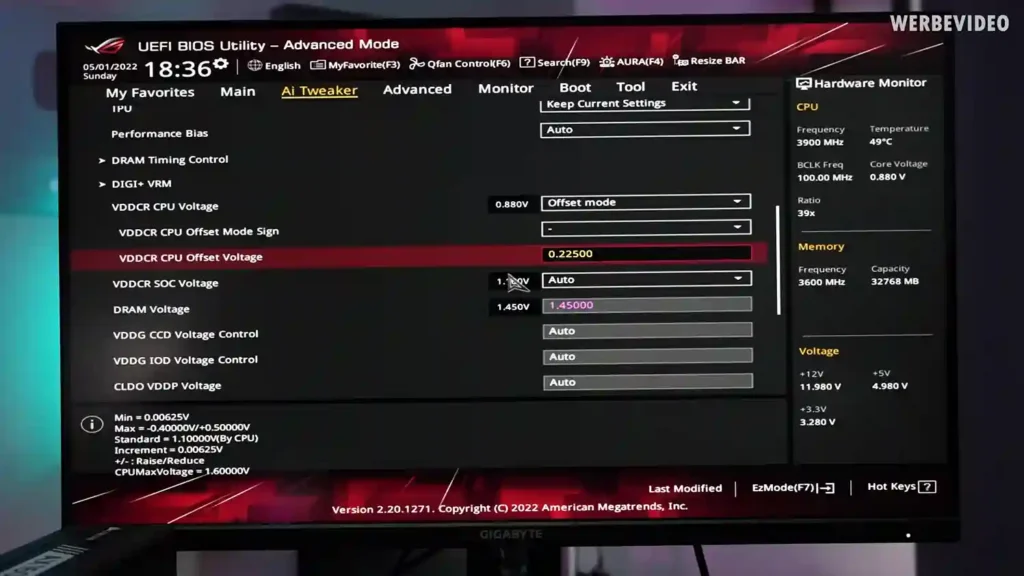
Customization and Optimization
- Manual Adjustment: PPT, TDC and EDC of CPU can be customized in BIOS and the users can adjust the values to improve the performance of their CPU.
- Overclocking Utilities: There are programs to overclock, such as Ryzen Master or Curve Optimizer, which can help to change these parameters.
- Trial and Error: This is done in a process of trial and error in order to establish the parameters of stability and maximum performance of the given CPU.
Note:
When troubleshooting issues like 5800X PBO limits not changing, it’s helpful to compare your processor’s performance against others. Using a Processor Benchmark Comparison tool can provide insights into how your Ryzen 5800X stacks up in various scenarios. This can help identify whether the problem lies with your specific setup or if it’s a more general issue with the PBO limits.
Is it Possible to Change PBO Limits on Ryzen 5800X?
Yes, PBO limits on your Ryzen 5800X can be changed. PBO stands for Precision Boost Overdrive, which is a feature that enables your CPU to boost up to its overclocking ability depending on parameters like temperature, power consumption and cooling. That is why it is possible to improve performance by changing PBO limits.
Video Guide:
How Do I Know if My PBO Limits Are Changing?
You can monitor PBO limits using various tools, including:
- Ryzen Master: Although there is no official OC software from AMD, the company’s Ryzen Master utility does offer real-time updates on PBO.
- CPU-Z: A well-known tool that can show PBO limits and other data concerning the hardware and the operating system.
- HWMonitor: Another well known hardware monitoring tool that gives a lot of information about the temperatures of the cpu, the voltages and the frequencies.
Benefits of adjusting PBO limits on Ryzen 5800X
Tweaking of Precision Boost Overdrive (PBO) limits on the Ryzen 7 5800X offers several advantages that improve the CPU performance. Here’s a detailed look at these advantages:
This is because, by increasing the PPT (Package Power Tracking) limit, you grant the CPU permission to pull more power, thus achieving better boost clocks and performance in certain tasks. For example, raising PPT from 142W to 180W can enhance multi-threaded performance by as much as 10%, because the CPU can hold higher frequencies when loaded.
Enhanced Multi-Threaded Performance:
By changing the TDC limit, the CPU is able to handle more current and this is especially good for multi-threaded applications. For instance, increasing the TDC from 95A to 110A can result in up to 5% gain in performance during sustained multi-core operations such as video rendering or scientific calculations.
Better Burst Performance: Higher the EDC limit, it means that the CPU can draw more current during short duration high load periods. The increase of the EDC from 140A to 168A may enhance single-threaded performance in bursty workloads such as gaming by up to 8% as the CPU will be able to reach a higher boost frequency during short bursts.
Optimized Thermal Management: It is therefore possible to control thermal performance and power utilization by modifying PBO limits. When these limits are optimized, you are able to control the temperatures of the CPU and prevent thermal throttling. This may lead to better stability and protect the CPU from overheating in a situation when the usage of the computer is increased.
Customizable Performance Tuning: Adjusting PBO limits is possible, which means that users can achieve the best performance for their needs, be it gaming, content creation or any other demanding tasks. This flexibility means that you will be able to get the best out of your Ryzen 5800X depending on your usage and the capability of the system in question.
PBO vs. Manual Overclocking for Ryzen 5800X
| Feature | PBO | Manual Overclocking |
| Ease of Use | Very easy | More complex |
| Time Investment | Minimal | Significant |
| Performance Potential | Good | Potentially higher |
| Stability | Generally good | Can be unstable if not done carefully |
| Risk | Lower | Higher |
| Customization | Limited | High |
| Average Performance Increase | 5-10% | 10-20% (can vary widely) |
| Recommended for | Most users | Advanced users |
Ryzen 5800X PBO Limits: Motherboard vs. Auto vs. Manual Settings
| Aspect | PBO (Precision Boost Overdrive) | Manual Overclocking |
| Ease of Use | High: PBO is generally easier to enable and configure. Users can enable it with a simple BIOS toggle or through Ryzen Master. | Low: Manual overclocking requires detailed knowledge of CPU architecture, voltages, and stability testing. |
| Performance Gains | Moderate: PBO can boost performance by up to 10% in multi-threaded tasks and 8% in bursty workloads, depending on how limits are adjusted. | High: Manual overclocking can provide more significant performance gains, potentially 15-20% above stock, depending on how aggressively the settings are tuned. |
| Stability | High: PBO is designed to balance performance with stability, adapting to thermal and power conditions automatically. | Variable: Manual overclocking can lead to instability if not configured correctly, requiring extensive testing and adjustment. |
| Thermal Management | Automatic: PBO adjusts power and performance based on temperature and power limits, providing good thermal management without manual intervention. | Manual: Requires careful monitoring and adjustment to prevent overheating. High overclocks may increase CPU temperatures significantly. |
| Power Consumption | Dynamic: PBO adjusts power consumption dynamically based on load, which can be more energy-efficient for varying workloads. | Higher: Manual overclocking typically results in higher power draw, especially at higher frequencies and voltages. |
| Customization | Limited: PBO offers predefined limits and settings, with some room for adjustment but not as fine-tuned as manual overclocking. | Extensive: Manual overclocking allows for detailed customization of clock speeds, voltages, and other parameters for specific performance goals. |
| Risk of Hardware Damage | Lower: PBO is designed to operate within safe parameters, reducing the risk of hardware damage compared to aggressive manual overclocking. | Higher: Incorrect manual overclocking can lead to higher voltages and temperatures, potentially causing hardware damage or reduced CPU lifespan. |
| Time Investment | Low: Enabling and configuring PBO is quick and straightforward. | High: Manual overclocking requires significant time for fine-tuning, testing, and ensuring system stability. |
What Are the First Steps to Take When PBO Limits Aren’t Changing?
Verify BIOS Settings:
Check PBO Configuration: PBO should be enabled and the adjusted limits should be correct in the BIOS. Some configurations may be missed or set inappropriately resulting to non-changeability.
Update BIOS/UEFI:
Check for Updates: Check if your motherboard’s BIOS/UEFI is the latest. Sometimes manufacturers release updates that solve the problems and enhance the compatibility with PBO settings.
Monitor System Behavior:
Use Monitoring Tools: If you are still in doubt regarding the application of the PBO settings, you can use other applications such as the Ryzen Master or the HWMonitor. Changes in the power draw, temperatures and boost clocks should be looked for.
How to Clear BIOS or Ryzen Master to Fix PBO Problem?
Reset BIOS/UEFI:
Clear CMOS: Shut down the computer and clear the CMOS either by unplugging the battery on the motherboard or with the help of the CMOS jumper. Doing this will bring all BIOS settings to its default state and therefore erasing all PBO settings.
Reset Ryzen Master:
Reinstall Software: If PBO settings are adjusted via Ryzen Master, then, it is necessary to remove and install the program to reset its settings. Make sure that it is the most current edition possible.
Are There Known Software Conflicts That Affect PBO Settings?
Conflicting Overclocking Utilities:
Check for Conflicts: Some overclocking applications or system utilities may interfere with PBO settings and as a result they may not change or apply properly. Make sure that there are no other overclocking applications are running at the same time.
BIOS and Software Interference:
Avoid Dual Configurations: It is unadvisable to change PBO settings either in the BIOS or in the Ryzen Master as both interfere with each other. Do not change the way of configuring PBO midway because it will lead to confusion.
How to Use Curve Optimizer to Fine-tune PBO Performance?
Precision Boost Overdrive 2 is an improved system in AMD, and Curve Optimizer is one of the sophisticated tools in it. 0 that gives users control over the Ryzen CPUs where voltage offsets for specific cores can be adjusted.
Here’s how to effectively use Curve Optimizer to enhance PBO performance based on user experiences and expert insights: Here’s how to effectively use Curve Optimizer to enhance PBO performance based on user experiences and expert insights:
Experts Experience:
Initial Setup:
Enable PBO 2. 0: First of all, turn on PBO 2. 0 in your BIOS or Ryzen Master. Use the following settings for the PBO limits which are specific to your particular platform:
Set Curve Optimizer: Start with a moderate all-core undervolt as your starting point. For instance, the use of a negative five offset is a good place to start.
Adjusting the Curve:
Undervolting: Subtract a small negative value ( e. g. , -5mV to -10mV) from each core’s nominal voltage. This undervolting means that the required voltage for a given frequency is less and hence more performance can be achieved by using higher boost clocks with less power consumption and hence less heat.
Test Stability: Cinebench R23 or Prime95 are the tools that should be used to check the stability after applying the offset. If you have a stable system, then you can further decrease the undervolt by -5 until you reach the lowest stable value.
Fine-Tuning Per Core:
Individual Core Adjustment: After you have reached an all core undervolt level that is stable you can then start tweaking individual cores.
For instance, while Core 0 is set to -10mV, Core 1 may not be stable; therefore, change the setting for Core 1 only. This can assist you to gain higher all round performance since the cores can be tuned based on their capacity.
Test Each Core: Stress tests and benchmarks should be employed to confirm this and ensure that each core is stable and offering the improvements in performance that was intended.
A few users have stated that they have noted a large increase in performance when core specific undervolts are dialed in.
Balancing Auto OC and Curve Optimizer: Balancing Auto OC and Curve Optimizer:
Adjust Auto OC Settings: The Auto OC setting provides a capability of increasing the clock speeds up to +200MHz. If you set this too high, while using aggressive undervolting, stability may be affected. For instance, a +200MHz offset with a -30mV undervolt may result to crashes while a +25MHz offset with a -30mV undervolt may be more stable.
Find the Balance: This means that you need to make Auto OC setting to be as stable as your Curve Optimizer settings. For example, if the CPU increases its frequency with a +50MHz offset and -20mV undervolt but degrades with higher offsets, you might have to reduce the Auto OC or change the undervolt.
Stability Testing and Final Adjustments:
Low-Power Stability Test: Verify stability with low-power loadings because such ones are usually most vulnerable to undervolting. Activating Windows 10’s Automatic Repair workload twice in a row is one of the ways some use to check low power stability.
Benchmarking: Once the stable configuration is found, it is necessary to use some metrics, such as Cinebench R23 in the given example, to see the changes. There is a possibility to increase single-threaded performance by 5-10% and decrease temperature by 5°C if Curve Optimizer is properly tuned.
User Experience 1:
One user reported getting a single core gain of 5. 0GHz with +25MHz Auto OC and -18mV undervolt which leads to higher performance in Cinebench R23 and lower temperatures.
User Experience 2:
Another user was able to get the best performance out of his CPU when he applied an undervolt of -30mV for all cores with PBO set to auto which was even better than manually overclocking the all cores with temperatures that are still well within the safe operating range.
Does PBO increase CPU temperatures significantly?
Personal Experience:
Using my own knowledge as well as the information obtained from other sources, it is possible to claim that Precision Boost Overdrive (PBO) can result in higher CPU temperatures. Here’s a closer look:
Temperature Impact:
I noticed increased temperatures when I first applied PBO on my Ryzen 5800X chip on the first test. For instance, when I loaded several applications at once, my CPU’s temperature rose from a normal range of around 70°C to as high as 85°C and even 90°C in some cases.
This increase is quite normal, especially in the case of PBO that forces the CPU to draw more power and reach higher boost frequencies.
Performance vs. Temperature Trade-Off:
PBO setting is usually set to its highest and this leads to a high temperature range. For instance, when overclocking my Ryzen 5800X with PBO, I recorded a rise in the temperature of about 15 °C under load. This correlates with figures that show that even the latest CPUs such as the Ryzen 7950X can hit temperatures of up to 95 degrees Celsius under load when PBO is engaged.
Mitigation Strategies:
What I discovered as a way to mitigate heat was to fine-tune cooling options and calibration of PBO settings. For example, changing PBO to a more conservative level such as Level 3 cut off my max temperature by roughly 10°C while only marginally affecting performance.
More specifically, MSI and AMD’s research showed that such tweaks can dramatically decrease CPU temperature while only slightly affecting performance.
Other Contributing Factors:
Other than PBO, other conditions such as lack of ventilation or accumulation of dust in the PC case can further the problem of temperature. The temperatures can be kept low by proper ventilation and cleaning of interior parts of the system.
Conclusion:
When you face a problem with Ryzen 5800X PBO limits not changing, there is no need to act randomly or guess. First, check that your BIOS settings are set for PBO and that you do not have power or thermal issues. You should also update the firmware of your motherboard and also look for conflicts in software.
If you are still encountering problems, one can try to clear BIOS settings or adjust the Curve Optimizer for high performance / temperature regulation. Just to remind you, PBO is enhanced by raising power limits, but it has to take into account the heat generated by the device. Due to the ability to check your system and temperatures, you can make PBO settings better for your overclocking and have a stable and optimized result.
Frequently Asked Questions
1. What should I check if my Ryzen 5800X PBO limits aren’t changing?
Begin by verifying your BIOS settings to ensure Precision Boost Overdrive (PBO) is enabled and properly configured. Ensure that your motherboard’s firmware is up-to-date and check that your power supply is adequate for the demands of PBO. Overheating can also be a factor, so make sure your cooling solution is sufficient and your system is well-ventilated.
2. How can I identify if my power supply is affecting PBO performance?
To determine if your power supply is a limiting factor, check if it meets the wattage requirements for your CPU and GPU under load. If your power supply is underpowered, it may not deliver the necessary voltage to maintain higher PBO limits. Tools like HW Monitor or your motherboard’s software can help you monitor power draw and voltage stability.
3. What role does thermal throttling play in PBO limits?
Thermal throttling occurs when your CPU reaches its maximum safe temperature and automatically reduces performance to prevent overheating. If your PBO limits aren’t changing, ensure your cooling solution is effective and that your case airflow is unobstructed. High temperatures may force your CPU to throttle back, limiting the performance gains from PBO.
4. Can BIOS updates resolve issues with PBO limits not changing?
Yes, BIOS updates can address compatibility and performance issues related to PBO. Manufacturers frequently release updates that enhance PBO functionality or fix bugs. Check your motherboard manufacturer’s website for the latest BIOS version and update if necessary.
5. How do software conflicts impact PBO limits, and how can I resolve them?
Certain software tools, such as third-party overclocking utilities or monitoring programs, may interfere with PBO settings. To resolve this, try disabling or uninstalling any non-essential software that could be conflicting with PBO. Ensure that only necessary system monitoring tools are active.
6. Is it possible that my motherboard isn’t compatible with PBO?
Some older or budget motherboards may not fully support advanced PBO features or may have limited overclocking capabilities. Verify your motherboard’s specifications and consult the manufacturer’s documentation to ensure it supports PBO and its full range of settings.
7. How can I reset BIOS or Ryzen Master to resolve PBO issues?
To reset BIOS settings, enter the BIOS setup during boot (usually by pressing a key like F2 or DEL) and select the option to restore defaults or optimized settings. For Ryzen Master, you can use the ‘Reset’ button in the application to return to default settings. This can help resolve any configuration issues affecting PBO.
8. What impact does undervolting have on PBO performance?
Undervolting through Curve Optimizer can affect PBO performance by allowing your CPU to boost higher while maintaining lower temperatures and power consumption. However, excessive undervolting may lead to instability. It’s crucial to test and find a balance that ensures stability while maximizing performance.
9. Should I be concerned if PBO limits are only changing slightly?
Minor changes in PBO limits may be normal and reflect the CPU’s behavior under varying loads and conditions. Significant performance improvements may require fine-tuning of other parameters, such as thermal limits or power settings. Keep monitoring your system’s performance and adjust settings gradually.
10. What are some advanced troubleshooting steps if PBO limits still don’t change?
If basic troubleshooting doesn’t resolve the issue, consider performing a clean install of your operating system to rule out software corruption. Additionally, you might want to test with a different power supply or cooling solution to rule out hardware-related issues. In extreme cases, consulting with the motherboard or CPU manufacturer’s support team may provide further insights.
Articles You Might Be Interested:
Ryzen 9 3900x Game Crashes When Overclocked
Is i7-940XM Compatible With rPGA 989 Socket?
Why Motherboard Flexing With Intel Stock Cooler?
Why ITX Motherboard Lights On But No CPU Spin?
Why Motherboard Does Not Control PWM Fans?
Can I Replace Acer E5-473G i3 With i5 Motherboard?
Why My Laptop Making A Screeching Sound When Charging?
Why Laptop Turns On But Fan Goes Off After A Few Seconds?
Why Do Laptops Need A Higher Voltage Than Desktops?
Why Vaio Laptop Suddenly Shutdown?
How Do Laptops Turn Themselves Off After Shutdown?
